
- Homepage
- Brand
- Bosch (8)
- Clock (16)
- Electric (9)
- Frigidaire (3)
- Ge General Electric (24)
- Ge, General Electric (6)
- General (82)
- General Electric (1049)
- General Electric Co. (4)
- General Electric Ge (9)
- General Mills (3)
- Reddy Kilowatt (6)
- Tamiya (12)
- Team Associated (7)
- Telechron (40)
- Universal (8)
- Vintage (6)
- Western Electric (4)
- Zenith (5)
- Zippo (6)
- Other (2201)
- Department
- Model
- Power Source
- Style
- Type
- Alarm Clock (53)
- Blower / Utility (11)
- Body Shells (10)
- Boombox (38)
- Box (29)
- Clock Radio (54)
- Cooking Ranges (12)
- Desk Clock (59)
- Fan (18)
- Floor (13)
- Pedestal / Standing (18)
- Pedestal Fan (8)
- Search / Spot Light (10)
- Standalone Mixer (7)
- Table / Desk (381)
- Table Lamp (10)
- Toaster Oven (29)
- Twin (14)
- Vacuum Tube (10)
- Wall Clock (223)
- Other (2501)
Very RARE Vintage General Electric Medallion Home Advertisement Sign, 1950s
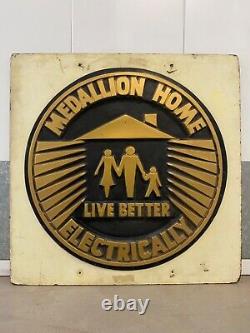

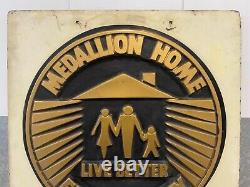
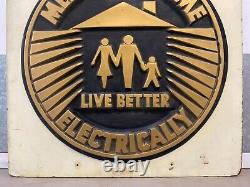
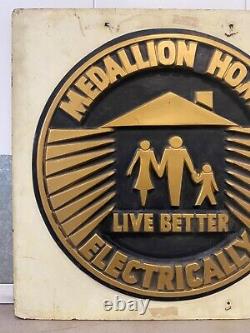
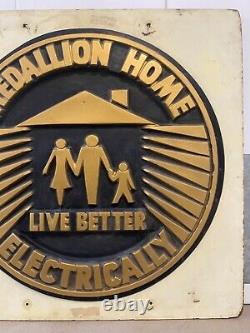
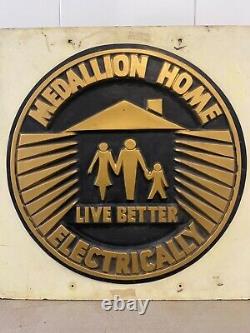
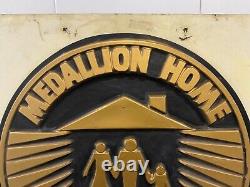
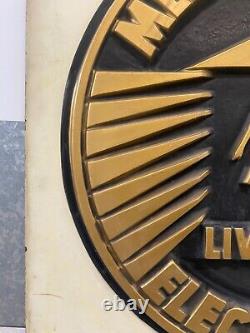
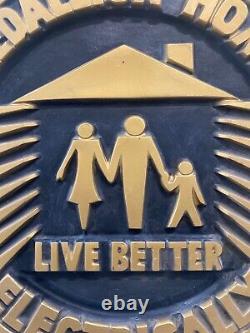


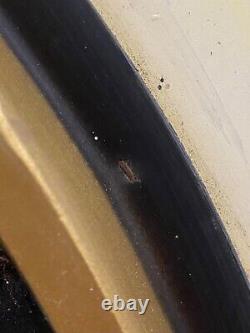

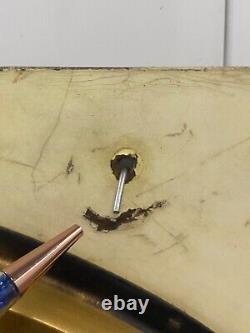


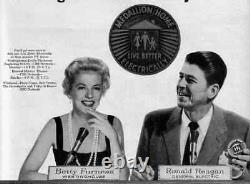
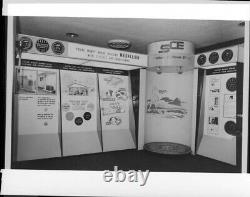
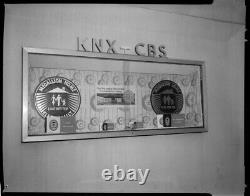


This is a seldomly seen and Very RARE Vintage General Electric Westinghouse Medallion Home Advertisement Sign, likely dating to the late 1950's. This piece has a prominent three-dimensional emblem which reads: Medallion Home Live Better Electrically. The emblem seen on this sign is the first iteration of the logo design, which would later change to "Gold Medallion Home" in the 1960's. This sign is comprised of a three-dimensional medallion, which appears to be made of a hard plastic, affixed to a particle board or Masonite backing.
It has four drilled holes for the piece to be hung, which are on the top and bottom of the sign. Approximately 24 x 24 inches. Good condition for age, storage, and public display use, with moderate scuffing and edge wear please see photos. You will not find another comparable example of this sign, anywhere, except for in institutional collections. Acquired in Los Angeles County, California.
If you like what you see, I encourage you to make an Offer. Please check out my other listings for more wonderful and unique artworks! Live Better Electrically: The Gold Medallion Electric Home Campaign. One of the most effective mass marketing home campaigns of all time was the "Live Better Electrically" (LBE) program of the post-World War II era. It began in the mid 1950s when the General Electric (GE) and Westinghouse corporations decided to co-sponsor a multi-million dollar nationwide campaign to promote the sales of electric appliances and to tout the benefits of electric power. General Electric provided the main support for the program, which launched in March of 1956. At the time, utility companies were rushing to meet the increased demand for electricity in postwar America. However, as more power plants came on line the cost of electricity decreased. For GE and Westinghouse, the creation of a new market for electric heat also promised to increase company profits. Supported nationwide by 900+ electric utilities and 180 electricity manufacturers, the electricity industry launched the LBE campaign through a variety of media outlets. To further the new program, in October 1957 the National Electrical Manufacturers Association launched the "Medallion Homes" campaign, which sought to sell initially 20,000 all-electric homes nationwide within a year.The program had five basic goals: 1 to provide prospective homebuyers with a recognized symbol of electrical excellence for new home construction 2 to raise the electrical standards in new construction 3 to help builders sell homes by educating their customers to the benefits of electrical living 4 to show existing homeowners electrical features and fixtures that were needed in their present homes 5 to give national support to existing programs that were being sponsored by local utilities to upgrade existing home electrification. The LBE initiative and Medallion Homes program were heavily promoted through a variety of magazine and newspaper ads, as well as TV spots, and even radio jingles. The main campaign spokesman was then-actor Ronald Reagan, the host of General Electric Theater. As part of the show, Regan took television audiences on a tour of his own Pacific Palisades home, as well as a variety of GE Research facilities and manufacturing plants. Guest speakers included television and radio comedian, personality, and singer Fran Allison (for Whirlpool), and actress, consumer advocate, and current affairs commentator, Betty Furness (for Westinghouse).
To earn a LBE Medallion emblem a house had to be solely sourced with electricity for heat, light, and power. The house also had to have an electric range or built-in oven and surface units, and an electric refrigerator and/or refrigerator/freezer in the kitchen. An optional appliance might be a dishwasher, food waste disposer, clothes dryer or even an air conditioner. Full 150 ampere service was also required, with a specified number of outlets and switches per linear foot of wall space. And finally, to meet the requirement of "modern living, " Medallion Homes had high standard for built-in illumination throughout the house, initially an unusual feature within new home construction. The homes that met LBE standards could be marked with a 3" inch brass plaque emblazed with the "Live Better Electrically logo. The brass plaque was typically found near the front entry door and could be embedded in the concrete sidewalk, patio or doorstep, or affixed to the wall as a stand-alone marker. Some plaques were incorporated into a doorbell or knocker. For those who wanted a less permanent marker, a 6 inch decal could be affixed to a window.The title of the campaign changed slightly over the years, but the Live Better Electrically logo remained a constant. Medallion Home - Live Better Electrically. Gold Medallion Home - Live Better Electrically. Total Electric Award - Gold Medallion Home - Live Better Electrically.
Light for Living - Gold Medallion Home. Across the county and here in Washington state, hundreds of developers and builders jumped on the LBE bandwagon.
The Medallion Home badge was a prominent feature of local Parade of Homes programs for numerous years. Entire neighborhoods such as the Somerset development in Bellevue (1961), were planned and built as Medallion Homes. With inexpensive power in the Pacific Northwest, GE and Westinghouse's goal for increasing electrical standards in home construction was easily met. For example, in 1958 Seattle City Light proclaimed that 99.4% of all of Seattle's new single-family homes were all-electric. The LBE campaign positioned natural gas, the biggest power source of the time, as an outmoded method to operate appliances like furnaces, cooking ranges, water heaters, and clothes dryers. Living in a Medallion home was marketed as the apex of modern living. To heighten their modern, futuristic feel, many all-electric homes also had unusual electrical amenities such as electric curtain rods and baseboard heating, or even such unusual items as task lighting under a woman's dressing table for pedicures. By all accounts the Medallion Home campaign was a huge success. Some estimates note that the nationwide goal of about 1 million all-electric homes was achieved, although specific data on the actual number built is unknown. In Seattle, for example, dwellings were still being advertised as a Medallion Home as late as 1983. By Michael Houser, State Architectural Historian. Gold Medallion Home: Meaning and History. Flashback to the 1960s, When Electric Homes Wore Badges. If you've recently bought a mid-century modern home. In a suburban area and found a gold medallion affixed to the exterior wall, you might be wondering what this is all about. During the 1960s and'70s, this badge meant that you were entering a house of technological marvels. No, it did not mean that the home had a "Jetsons"-like system of automatic dog washers and food preppers. It simply meant that the home had a relatively innovative energy system.Of the time: It was 100 percent electrified. What Is a Gold Medallion Home? During the 1960s and'70s, the Gold Medallion was a decal on a home's exterior entryway and signified that the house is technologically advanced. Some of this technology included an electric washer and dryer, waste disposal, refrigerator, and electric heating. From "Dirty" Energy to Clean Electricity.
Generally speaking, homes built before World War II weren't as clean or efficient as homes today. Many had coal-burning furnaces in the basement, and coal would blacken everything around it. Some homes used fuel oil that was delivered by trucks and piped into the basement, where it was burned in the furnace. Some homes still relied on dirty-burning and inefficient fireplaces. To supplement their main heat sources. There were (and still are) physical manifestations of older energy production everywhere. Houses on the East Coast in the 1960s still had coal chutes leading into the basement.Tanks for fuel oil may be buried on a home's property-and are now considered a liability and a bone of contention whenever it comes time to sell a house. It was considered a great step up to modernity to use electricity. Electric water heaters didn't give off smoke or fumes; they didn't even need flues. Electric heating systems could pump hot air throughout a house.
By 1960, more than 850,000 families were living in total-electric Gold Medallion homes. Many of these were in western cities such as Los Angeles, Palm Springs, Phoenix, and Seattle, which experienced a great deal of post-World War II building. Unlike the mid-century design staples of. Gold Medallion homes, many of today's homes have gone in the opposite direction. Switching electric services to natural gas is, in some cases, a cheaper and more efficient energy source than electricity. Also, it doesn't take much investigation to suspect some marketing spin at play. An all-electric home may not burn coal on-site, but because most electricity in the United States is produced by burning coal, a Gold Medallion house is essentially all-coal-powered. Signs of a Modern Home. The standard mark of a Gold Medallion home was a rectangular brass badge affixed near to the doorbell, though the badge could be mounted in many places, typically near the entrance of the home. Some were even embedded in the sidewalk outside.The phrasing of the badge changed over the years. The tagline is probably better remembered: "Live Better Electrically, " perhaps a play on the earlier, more famous, and often mocked "Better Living Through Chemistry" slogan of a large science and chemical company named DuPont. Gold Medallion Home-Live Better Electrically. Total Electric Award-Gold Medallion Home-Live Better Electrically. In addition to the brass badge, 7-inch window stickers were available.
The Gold Medallion program was advertised largely when it first began, and several notable sponsors played a part in its growth. The Edison Electric Institute (EEI) and General Electric heavily promoted the Gold Medallion program through magazine and newspaper ads, TV spots, and radio jingles. President Ronald Reagan got on the bandwagon for all-electric living in his role as spokesman for General Electric. The program also awarded allowances to builders who built Gold Medallion homes.Gold Medallion status was a convenient marketing tool: After World War II, home building. Builders had to add extras and bonuses to bring buyers to their homes and developments. A February 10, 1963 article about the Gold Medallion program states, Back in the'50s, builders needed no special inducements to attract buyers, but now the market is reversed.
The building market is on a competitive basis and now the consumer must be wooed. Live Better Electrically Medallion Homes Introduced in 1957. Today, like glittering jewels against a countryside of "stoneage" homes, which lack sufficient housepower and modern appliances. The Medallion Homes sparkle with excitement making possible a more comfortable and luxurious way of living.
UTILITY COMPANIES, home builders and electrical contractors made this contrast possible by fulfilling the quality concept of the Medallion Home as it was conceived under the sponsorship of its parent program, Live Better Electrically. The result: More than 70,000 Medallion Homes were built in 1958 with specified standards of electrical excellence in adequate wiring, appliance equipment and lighting. This year's estimate of 100.000 new Medallion Homes to be constructed is a conservative one, according to the Medallion home sponsors, and will undoubtedly be surpassed before the year's end. THE UNPARALLELED success of Medallion Homes so far was achieved in cities, suburbs, towns and developments all across the nation through the efforts of more than 280 local electric utili.Ties who award the Medallion I and almost 5.000 private home builders (who earned the right to display the Medallion). The reason for the success was two-fold. Primarily, more and more families are and want to be homeowners.
Today's homeowner wants a fresh start a modern start. Hence, the Medallion had an enviable appeal, a new home with electrical excellence. He knew the new home had full house power and adequate wiring, at least 100-ampere entrance service and a minimum of 20 electric circuits within the house with ample outlets and switches for present and future needs.
